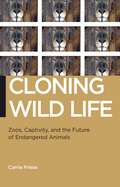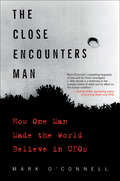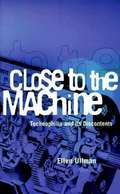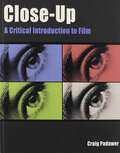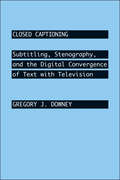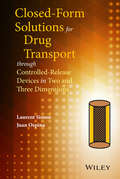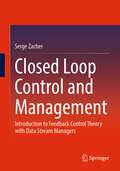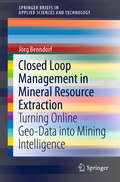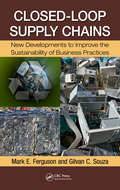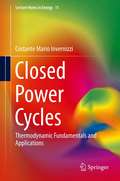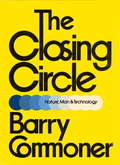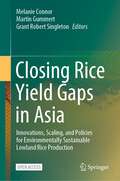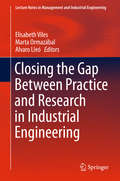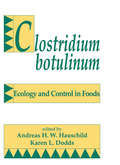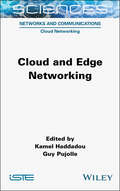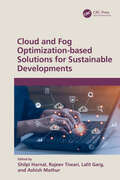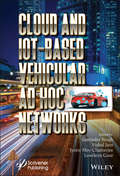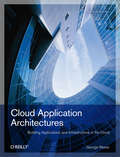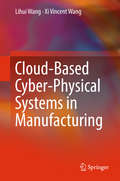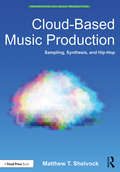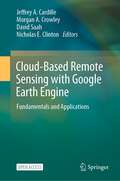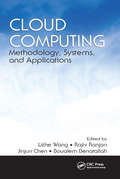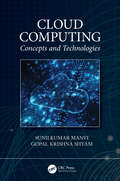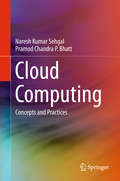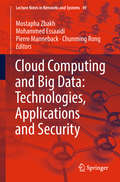- Table View
- List View
Cloning Wild Life: Zoos, Captivity, and the Future of Endangered Animals (Biopolitics #14)
by Carrie FrieseThe natural world is marked by an ever-increasing loss of varied habitats, a growing number of species extinctions, and a full range of new kinds of dilemmas posed by global warming. At the same time, humans are also working to actively shape this natural world through contemporary bioscience and biotechnology. In Cloning Wild Life, Carrie Friese posits that cloned endangered animals in zoos sit at the apex of these two trends, as humans seek a scientific solution to environmental crisis. Often fraught with controversy, cloning technologies, Friese argues, significantly affect our conceptualizations of and engagements with wildlife and nature.By studying animals at different locations, Friese explores the human practices surrounding the cloning of endangered animals. She visits zoos—the San Diego Zoological Park, the Audubon Center in New Orleans, and the Zoological Society of London—to see cloning and related practices in action, as well as attending academic and medical conferences and interviewing scientists, conservationists, and zookeepers involved in cloning. Ultimately, she concludes that the act of recalibrating nature through science is what most disturbs us about cloning animals in captivity, revealing that debates over cloning become, in the end, a site of political struggle between different human groups. Moreover, Friese explores the implications of the social role that animals at the zoo play in the first place—how they are viewed, consumed, and used by humans for our own needs. A unique study uniting sociology and the study of science and technology, Cloning Wild Life demonstrates just how much bioscience reproduces and changes our ideas about the meaning of life itself.
The Close Encounters Man: How One Man Made the World Believe in UFOs
by Mark O'ConnellMeet the astronomer who invented the concept of “Close Encounters” with aliens, inspired a classic sci-fi film, and made a nation want to believe in UFOs.In June 1947, private pilot Kenneth Arnold looked out his cockpit window and saw a group of nine silvery crescents weaving between the peaks of the Cascade Mountains at an estimated 1,200 miles an hour. The media, the military, and the scientific community—led by J. Allen Hynek, an astronomer hired by the Air Force—debunked this and many other Unidentified Flying Object sightings reported across the country. But after years of denials, Hynek made a shocking pronouncement: UFOs are real.Thirty years after his death, Hynek’s agonizing transformation from skeptic to true believer remains one of the great misunderstood stories of science. In this definitive biography, Mark O’Connell reveals for the first time how Hynek’s work both as a celebrated astronomer and as the U.S. Air Force’s go-to UFO expert for nearly twenty years stretched the boundaries of modern science, laid the groundwork for acceptance of the possibility of UFOs, and was the basis of the hit film Close Encounters of the Third Kind. With unprecedented access to Hynek’s personal and professional files, O’Connell smashes conventional wisdom to reveal the intriguing man and scientist behind the legend. Tracing Hynek’s career, O’Connell examines his often-ignored work as a professional astronomer to create a complete portrait of a groundbreaking enthusiast who became an American cult icon and transformed the way we see our world and our universe.“Scholastic and casual readers will find this fact-packed biography informative and enjoyable; highly recommended for school science departments.” —Library Journal
Close to the Machine: Technophilia and its Discontents
by Ellen UllmanA candid account of the life of a software engineer who runs her own computer consulting business in San Francisco. What is it about the numerical, seemingly inhuman world of computing that holds such powerful, wholly human allure?
Close-Up: A Critical Introduction to Film
by Craig PadawerClose-Up: A Critical Introduction to Film 1st Edition
Closed Captioning: Subtitling, Stenography, and the Digital Convergence of Text with Television (Johns Hopkins Studies in the History of Technology)
by Gregory J. DowneyThis engaging study traces the development of closed captioning—a field that emerged in the 1970s and 1980s from decades-long developments in cinematic subtitling, courtroom stenography, and education for the deaf. Gregory J. Downey discusses how digital computers, coupled with human mental and physical skills, made live television captioning possible. Downey's survey includess the hidden information workers who mediate between live audiovisual action and the production of visual track and written records. His work examines communication technology, human geography, and the place of labor in a technologically complex and spatially fragmented world. Illustrating the ways in which technological development grows out of government regulation, education innovation, professional profit-seeking, and social activism, this interdisciplinary study combines insights from several fields, among them the history of technology, human geography, mass communication, and information studies.
Closed-form Solutions for Drug Transport through Controlled-Release Devices in Two and Three Dimensions
by Laurent Simon Juan OspinaProvides solutions for two- and three-dimensional linear models of controlled-release systems Real-world applications are taken from used to help illustrate the methods in Cartesian, cylindrical and spherical coordinate systems Covers the modeling of drug-delivery systems and provides mathematical tools to evaluate and build controlled-release devices Includes classical and analytical techniques to solve boundary-value problems involving two- and three-dimensional partial differential equations Provides detailed examples, case studies and step-by-step analytical solutions to relevant problems using popular computational software
Closed Loop Control and Management: Introduction to Feedback Control Theory with Data Stream Managers
by Serge ZacherThe block diagrams as engineering means for closed loop control, which have been established by classic control theory for decades, are replaced in the above mentioned book by networks, the signals are replaced by data. It corresponds to the „Industry 4.0“ and to the structure of today’s automatic control systems. Thereby a classic closed loop is treated not isolated from other elements of nowadays automation like bus communication and process logical control, and is completed in proposed book with new control elements, so called data stream managers (DSM). The proposed book treats the control theory systematically like it is done in classical books considering the new concept of data management. The theory is accompanied in the book with examples, exercises with solutions and MATLAB®-simulations.
Closed Loop Management in Mineral Resource Extraction: Turning Online Geo-Data into Mining Intelligence (SpringerBriefs in Applied Sciences and Technology)
by Jörg BenndorfThis book describes an innovative closed-loop concept that allows the feedback of online data from operational monitoring to create mining intelligence. The application of this concept promises significant improvements in economic and environmental key performance indicators for any mining operation.Combining theory with industrial case studies, the book guides readers through this process by providing theoretical background, addressing practical issues related to operational implementation, and illustrating the impact on selected examples. This new concept is presented using the example of a bulk and gold mining application, but is applicable at any mine where grade control is important.The book is of interest to industrial professionals involved in operational monitoring, mining intelligence, and mine planning optimization, as well as to researchers and academics in the field of applied geostatistics.
Closed-Loop Supply Chains: New Developments to Improve the Sustainability of Business Practices (Supply Chain Integration Modeling, Optimization and Application)
by Mark E. Ferguson Gilvan C. SouzaClosed-loop supply chain activities such as remanufacturing, recycling, dismantling for spare parts, and reverse logistics have helped many companies tap into new revenue streams by finding secondary markets for their products, all while reducing their overall carbon footprint. Written by academic experts, in language that is accessible to practitioners, this authoritative resource examines recent research and case studies of companies running profitable reuse/remanufacture operations in various industries. It illustrates profitable practices in returned and recovered products, clearly explaining how to: design a reverse logistics network, conduct production planning, implement effective marketing strategies, and apply closed-loop supply chain strategies in industries besides manufacturing. From product development to materials to assembly and profitability, this complete resource explores the impact of these processes across all aspects of the supply chain.
Closed Power Cycles: Thermodynamic Fundamentals and Applications (Lecture Notes in Energy #11)
by Costante Mario InvernizziWith the growing attention to the exploitation of renewable energies and heat recovery from industrial processes, the traditional steam and gas cycles are showing themselves often inadequate. The inadequacy is due to the great assortment of the required sizes power and of the large kind of heat sources. Closed Power Cycles: Thermodynamic Fundamentals and Applications offers an organized discussion about the strong interaction between working fluids, the thermodynamic behavior of the cycle using them and the technological design aspects of the machines. A precise treatment of thermal engines operating in accordance with closed cycles is provided to develop ideas and discussions strictly founded on the basic thermodynamic facts that control the closed cycles operation and design. Closed Power Cycles: Thermodynamic Fundamentals and Applications also contains numerous examples which have been carried out with the help of the Aspen Plus®R program. Including chapters on binary cycles, the organic Rankine cycle and real closed gas cycles, Closed Power Cycles: Thermodynamic Fundamentals and Applications acts a solid introduction and reference for post-graduate students and researchers working in applied thermodynamics and energy conversion with thermodynamic engines.
Closing Circle
by Barry CommonerFrom Chapter One:This book . . . begins with the ecosphere, the setting in which civilization has done its great--and terrible--deeds. Then it moves to a description of some of the damage we have done to the ecosphere--to the air, the water, the soil. However, by now such horror stories of environmental destruction are familiar, even tiresome. Much less clear is what we need to learn from them, and so I have chosen less to shed tears for our past mistakes than to try to understand them. Most of this book is an effort to discover which human acts have broken the circle of life, and why. I trace the environmental crisis from its overt manifestations in the ecosphere to the ecological stresses which they reflect, to the faults in productive technology--and in its scientific background--that generate these stresses, and finally to the economic, social, and political forces which have driven us down this self-destructive course. All this in the hope--and expectation--that once we understand the origins of the environmental crisis, we can begin to manage the huge undertaking of surviving it.
Closing Rice Yield Gaps in Asia: Innovations, Scaling, and Policies for Environmentally Sustainable Lowland Rice Production
by Melanie Connor Martin Gummert Grant Robert SingletonThis open access book contributes not only to the scientific literature on sustainable agricultural development and in particular rice agriculture but also is highly valuable to assist practitioners, projects, and policymakers due to its sections on reducing carbon footprint, agricultural innovations, and lessons learned from a multi-country/multi-stages development project. The scope of the book is conceived as a detailed documentation of the implementation, dissemination, and impact of the CORIGAP project in Sri Lanka, Myanmar, Thailand, China, Vietnam, and Indonesia, with spill-over to Cambodia and the Philippines. It pulls together actionable research findings with the experience of bringing these findings into use. The aim of the book is to provide a wide array of pathways to impact for sustainable rice production in lowland irrigated rice-based agricultural systems. The book is written by local actors of the rice value chain, researchers, and engineers working on a range of best management practices, climate-smart rice production innovations, knowledge translation, and dissemination, as well as decision-making and policy aspects. It is envisioned that the contents of the book can be translated into messages that can help farmers, extension workers, policymakers, and funders of agricultural development, decide on implementing best management practices and climate-smart technologies in their agroecological systems by presenting the technological/practical options along the rice value chain and the partnerships and business models required for their implementation. The book is aimed at practitioners, extension specialists, researchers, and engineers interested in information on current best management practices, sustainable, and climate-smart rice production and constraints that need further investigation. Furthermore, the book is also aimed at policymakers and agricultural development funders required by public opinion and legally binding agreements to reduce greenhouse gas emissions, conserve biodiversity and increase agroecological practices, who are looking for research-based evidence to guide policymaking and implementation.
Closing the Gap Between Practice and Research in Industrial Engineering (Lecture Notes in Management and Industrial Engineering)
by Elisabeth Viles Marta Ormazábal Alvaro LleóThis book presents the proceedings of the XXII International Conference on Industrial Engineering and Operations Management, International IIE Conference 2016, and International AIM Conference 2016. This joint conference is a result of an agreement between ADINGOR (Asociaci#65533;n para el Desarrollo de la Ingenier#65533;a de Organizaci#65533;n), ABEPRO (Associa#65533;#65533;o Brasileira de Engenharia de Produ#65533;#65533;o), AIM (European Academy for Industrial Management) and the IIE (Institute of Industrial Engineers), and took place at TECNUN-School of Engineering (San Sebasti#65533;n, Spain) from July 13th to 15th, 2016. The book includes the latest research advances and cutting-edge analyses of real case studies in Industrial Engineering and Operations Management from diverse international contexts, while also identifying concrete business applications for the latest findings and innovations in operations management and the decisions sciences.
Clostridium Botulinum: Ecology and Control in Foods (Food Science And Technology Ser. #54)
by HauschildAn in-depth resource addressing the ecology of Clostridium botulinum which affects the degree of food contamination, and its control in various foods. The text summarizes worldwide data on this organism in food and the environment and the principles of its control in specific foods and products.
Cloud and Edge Networking
by Kamel Haddadou Guy PujolleA major transformation in the world of networks is underway, as the focus shifts from physical technology to software-based solutions. In this book, the authors present this new generation of networks that are based in the Cloud by detailing the transition from a complex environment to a simple digital infrastructure. This infrastructure brings together connected devices, the antennas that collect radio waves, the optical fibers that carry signals and the data center that handles all of the different processes. From this perspective, the data center becomes the brain, managing network services, controls, automation, intelligence, security and other applications. This architecture is relevant to carrier networks, the Internet of Things, enterprise networks and the global networks of the major Internet companies. Cloud and Edge Networking further discusses developments at the border of networks, the Edge, where data is processed as near as possible to the source. Over the next ten years, the Edge will become a major strategic factor.
Cloud and Fog Optimization-based Solutions for Sustainable Developments
by Shilpi Harnal Rajeev Tiwari Lalit Garg Ashish MathurCloud and Fog Optimization-based Solutions for Sustainable Developments discusses the integration of fog computing and the Internet of Things to provide scalable, secure, and cost-effective digital infrastructures for smart services in diverse domains: Highlights resource management solutions for the Internet of Things devices in fog computing architectures Discusses waste management using cloud and fog computing for sustainable development, and optimization of the Internet of Things in fog computing for fault tolerance Covers smart surveillance and monitoring using cloud and fog computing, and energy-efficient smart healthcare Explains energy-efficient frameworks for cloud-fog environments for sustainable development, and smart grid infrastructure using cloud and fog computing Presents the management of metropolitan mobility for public transport and smart vehicles with cloud and fog computing The text is primarily written for senior undergraduates, graduate students, and academic researchers in the fields of electrical engineering, electronics and communications engineering, computer science and engineering, and information technology.
Cloud and IoT-Based Vehicular Ad Hoc Networks
by Gurinder Singh Vishal Jain Jyotir Moy Chatterjee Loveleen GaurCLOUD AND IOT-BASED VEHICULAR AD HOC NETWORKS This book details the architecture behind smart cars being fitted and connected with vehicular cloud computing, IoT and VANET as part of the intelligent transport system (ITS). As technology continues to weave itself more tightly into everyday life, socioeconomic development has become intricately tied to ever-evolving innovations. An example of this is the technology being developed to address the massive increase in the number of vehicles on the road, which has resulted in more traffic congestion and road accidents. This challenge is being addressed by developing new technologies to optimize traffic management operations.This book describes the state-of-the-art of the recent developments of Internet of Things (IoT) and cloud computing-based concepts that have been introduced to improve Vehicular Ad-Hoc Networks (VANET) with advanced cellular networks such as 5G networks and vehicular cloud concepts. 5G cellular networks provide consistent, faster and more reliable connections within the vehicular mobile nodes. By 2030, 5G networks will deliver the virtual reality content in VANET which will support vehicle navigation with real time communications capabilities, improving road safety and enhanced passenger comfort.In particular, the reader will learn:A range of new concepts in VANETs, integration with cloud computing and IoT, emerging wireless networking and computing models New VANET architecture, technology gap, business opportunities, future applications, worldwide applicability, challenges and drawbacks Details of the significance of 5G Networks in VANET, vehicular cloud computing, edge (fog) computing based on VANET.AudienceThe book will be widely used by researchers, automotive industry engineers, technology developers, system architects, IT specialists, policymakers and students.
Cloud Application Architectures: Building Applications and Infrastructure in the Cloud (Theory in Practice (O'Reilly))
by George ReeseIf you're involved in planning IT infrastructure as a network or system architect, system administrator, or developer, this book will help you adapt your skills to work with these highly scalable, highly redundant infrastructure services. While analysts hotly debate the advantages and risks of cloud computing, IT staff and programmers are left to determine whether and how to put their applications into these virtualized services. Cloud Application Architectures provides answers -- and critical guidance -- on issues of cost, availability, performance, scaling, privacy, and security. With Cloud Application Architectures, you will:Understand the differences between traditional deployment and cloud computingDetermine whether moving existing applications to the cloud makes technical and business senseAnalyze and compare the long-term costs of cloud services, traditional hosting, and owning dedicated serversLearn how to build a transactional web application for the cloud or migrate one to itUnderstand how the cloud helps you better prepare for disaster recoveryChange your perspective on application scalingTo provide realistic examples of the book's principles in action, the author delves into some of the choices and operations available on Amazon Web Services, and includes high-level summaries of several of the other services available on the market today. Cloud Application Architectures provides best practices that apply to every available cloud service. Learn how to make the transition to the cloud and prepare your web applications to succeed.
Cloud-Based Cyber-Physical Systems in Manufacturing
by Lihui Wang Xi Vincent WangThis book presents state-of-the-art research, challenges and solutions in the area of cloud-based cyber-physical systems (CPS) used in manufacturing. It provides a comprehensive review of the literature and an in-depth treatment of novel methodologies, algorithms and systems in the area of architecture design, cyber security, process planning, monitoring and control. The book features detailed descriptions of how to derive solutions in a cloud environment where physical machines can be supported by cyber decision systems when engaged in real operations. It presents a range of novel ideas and is characterized by a balanced approach in terms of scope vs. depth and theory vs. applications. It also takes into account the need to present intellectual challenges while appealing to a broad readership, including academic researchers, practicing engineers and managers, and graduate students. Dedicated to the topic of cloud-based CPS and its practical applications in manufacturing, this book benefits readers from all manufacturing sectors, from system design to lifecycle engineering and from process planning to machine control. It also helps readers to understand the present challenges and future research directions towards factories of the future, helping them to position themselves strategically for career development.
Cloud-Based Music Production: Sampling, Synthesis, and Hip-Hop (Perspectives on Music Production)
by Matthew T. ShelvockCloud-Based Music Production: Samples, Synthesis, and Hip-Hop presents a discussion on cloud-based music-making procedures and the musical competencies required to make hip-hop beats. By investigating how hip-hop producers make music using cloud-based music production libraries, this book reveals how those services impact music production en masse. Cloud-Based Music Production takes the reader through the creation of hip-hop beats from start to finish – from selecting samples and synthesizer presets to foundational mixing practices – and includes analysis and discussion of how various samples and synthesizers work together within an arrangement. Through case studies and online audio examples, Shelvock explains how music producers directly modify the sonic characteristics of hip-hop sounds to suit their tastes and elucidates the psychoacoustic and perceptual impact of these aesthetically nuanced music production tasks. Cloud-Based Music Production will be of interest to musicians, producers, mixers and engineers and also provides essential supplementary reading for music technology courses.
Cloud-Based Remote Sensing with Google Earth Engine: Fundamentals and Applications
by Jeffrey A. Cardille Morgan A. Crowley David Saah Nicholas E. ClintonThis book guides its audience—which can range from novice users to experts— though a 55-chapter tour of Google Earth Engine. A sequenced and diverse set of lab materials, this is the product of more than a year of effort from more than a hundred individuals, collecting new exercises from professors, undergraduates, master’s students, PhD students, postdocs, and independent consultants. Cloud Based Remote Sensing with Google Earth Engine is broadly organized into two halves. The first half, Fundamentals, is a set of 31 labs designed to take the reader from being a complete Earth Engine novice to being a quite advanced user. The second half, Applications, presents a tour of the world of Earth Engine across 24 chapters, showing how it is used in a very wide variety of settings that rely on remote-sensing data This is an open access book.
Cloud Computing: Methodology, Systems, and Applications (Computing And Networks Ser.)
by Lizhe Wang, Rajiv Ranjan, Jinjun Chen and Boualem BenatallahCloud computing has created a shift from the use of physical hardware and locally managed software-enabled platforms to that of virtualized cloud-hosted services. Cloud assembles large networks of virtual services, including hardware (CPU, storage, and network) and software resources (databases, message queuing systems, monitoring systems, and load-balancers). As Cloud continues to revolutionize applications in academia, industry, government, and many other fields, the transition to this efficient and flexible platform presents serious challenges at both theoretical and practical levels—ones that will often require new approaches and practices in all areas. Comprehensive and timely, Cloud Computing: Methodology, Systems, and Applications summarizes progress in state-of-the-art research and offers step-by-step instruction on how to implement it. Summarizes Cloud Developments, Identifies Research Challenges, and Outlines Future Directions Ideal for a broad audience that includes researchers, engineers, IT professionals, and graduate students, this book is designed in three sections: Fundamentals of Cloud Computing: Concept, Methodology, and Overview Cloud Computing Functionalities and Provisioning Case Studies, Applications, and Future Directions It addresses the obvious technical aspects of using Cloud but goes beyond, exploring the cultural/social and regulatory/legal challenges that are quickly coming to the forefront of discussion. Properly applied as part of an overall IT strategy, Cloud can help small and medium business enterprises (SMEs) and governments in optimizing expenditure on application-hosting infrastructure. This material outlines a strategy for using Cloud to exploit opportunities in areas including, but not limited to, government, research, business, high-performance computing, web hosting, social networking, and multimedia. With contributions from a host of internationally recognized researchers, this reference delves into everything from necessary changes in users’ initial mindset to actual physical requirements for the successful integration of Cloud into existing in-house infrastructure. Using case studies throughout to reinforce concepts, this book also addresses recent advances and future directions in methodologies, taxonomies, IaaS/SaaS, data management and processing, programming models, and applications.
Cloud Computing: Concepts and Technologies
by Sunilkumar Manvi Gopal ShyamComprehensive and timely, Cloud Computing: Concepts and Technologies offers a thorough and detailed description of cloud computing concepts, architectures, and technologies, along with guidance on the best ways to understand and implement them. It covers the multi-core architectures, distributed and parallel computing models, virtualization, cloud developments, workload and Service-Level-Agreements (SLA) in cloud, workload management. Further, resource management issues in cloud with regard to resource provisioning, resource allocation, resource mapping and resource adaptation, ethical, non-ethical and security issues in cloud are followed by discussion of open challenges and future directions. This book gives students a comprehensive overview of the latest technologies and guidance on cloud computing, and is ideal for those studying the subject in specific modules or advanced courses. It is designed in twelve chapters followed by laboratory setups and experiments. Each chapter has multiple choice questions with answers, as well as review questions and critical thinking questions. The chapters are practically-focused, meaning that the information will also be relevant and useful for professionals wanting an overview of the topic.
Cloud Computing: Concepts And Practices
by Pramod Chandra P. Bhatt Naresh Kumar SehgalThis book provides readers with an overview of Cloud Computing, starting with historical background on mainframe computers and early networking protocols, leading to current concerns such as hardware and systems security, performance, emerging areas of IoT, Edge Computing etc. Readers will benefit from the in-depth discussion of cloud computing usage and the underlying architecture, with focus on best practices for using a dynamic cloud infrastructure, cloud operations management and cloud security. The authors explain carefully the “why’s and how’s” of Cloud Computing, so engineers will find this book and invaluable introduction to the topic.
Cloud Computing and Big Data: Technologies, Applications and Security (Lecture Notes in Networks and Systems #49)
by Mostapha Zbakh Mohammed Essaaidi Pierre Manneback Chunming RongThis book addresses topics related to cloud and Big Data technologies, architecture and applications including distributed computing and data centers, cloud infrastructure and security, and end-user services. The majority of the book is devoted to the security aspects of cloud computing and Big Data. Cloud computing, which can be seen as any subscription-based or pay-per-use service that extends the Internet’s existing capabilities, has gained considerable attention from both academia and the IT industry as a new infrastructure requiring smaller investments in hardware platforms, staff training, or licensing software tools. It is a new paradigm that has ushered in a revolution in both data storage and computation. In parallel to this progress, Big Data technologies, which rely heavily on cloud computing platforms for both data storage and processing, have been developed and deployed at breathtaking speed. They are among the most frequently used technologies for developing applications and services in many fields, such as the web, health, and energy. Accordingly, cloud computing and Big Data technologies are two of the most central current and future research mainstreams. They involve and impact a host of fields, including business, scientific research, and public and private administration. Gathering extended versions of the best papers presented at the Third International Conference on Cloud Computing Technologies and Applications (CloudTech’17), this book offers a valuable resource for all Information System managers, researchers, students, developers, and policymakers involved in the technological and application aspects of cloud computing and Big Data.
